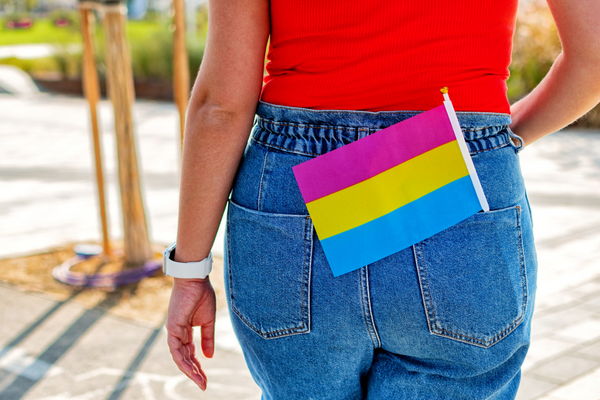It took a long time to feel comfortable with my sexuality – over twenty years, in fact. This wasn’t due to lack of acceptance from myself or those around me, but a lack of knowing how to identify. As a teen I was aware of the terms gay and lesbian, probably bisexual too. As for other sexualities, I didn’t know they existed, which made it impossible to find a label—until eventually I did.
I quietly wondered if I was a lesbian, but deep down knew that didn’t fit (no one in that camp could possibly have the feelings I had for Howard from Take That). Digging deep, I spoke to friends about my confusion, but this was a small town in the mid-90s. The people I thought I could trust mocked me, making my life miserable. I discovered it was easier to stay quiet and bury my need for a label.
During my twenties, still none-the-wiser, I knew I wasn’t straight but the terminology for what I was still eluded me. Being a cis female whose only relationships had been with cis males, maybe I didn’t need to come out? By the time I married my husband everyone assumed I was straight, and, for a while, I let them. Looking back, I can see it for what it was – a form of erasure I was inflicting on myself. Then again, there were fewer conversations about people attracted to multiple genders (or those who refused to subscribe to society’s obsession with gender) back then, and we’re only talking about the mid-2000s, not the Dark Ages.
I’d been married four or five years when I came out to friends using the term bisexual. As labels go, it wasn’t a perfect fit, but was the closest I was aware of. I knew what I felt, and I desperately needed a label to feel valid. I just couldn’t relate to any of the LGBT acronym. Even when I became aware of the additional ‘Q+’, it was unhelpful. People couldn’t even agree on what the Q stood for, and the +? Yes, it’s inclusive, but that’s no good when you’re searching for a word to describe an enormous part of yourself. It left me wondering how many other people were struggling with their identity (not just sexual orientation – their whole reason for being) because of the all-encompassing ‘Q+?’
I was in my thirties when I first read Juno Dawson’s This Book is Gay (which I highly recommend) and discovered the term pansexual. It was my light bulb moment, and everything clicked into place. My life – my feelings – suddenly made sense. That was me! That was my label! I still recall the sensation in my chest as I read the small section on pansexuality. Flutters in my stomach, a racing heart, a not-entirely-unpleasant nausea – not dissimilar to physical manifestations of the first flush of love, actually.
How had I not heard the term before? Although I asked the question, I knew. It was because of the all-encompassing ‘Q+.’ It’s hard not to feel less-than when your representation is through one catch-all symbol.
Representation of ‘+’ sexualities in popular culture is improving, with books and TV series such as Sex Education and Heartstopper leading the way. Visible role models are important too, which is why big-name stars coming out as ‘+’ (including Demi Lovato as nonbinary, Cara Delevingne as pansexual, and Tim Gunn and Janeane Garofalo as asexual) means so much to those of us who identify these ways. High-profile people speaking openly about their ‘+’ sexuality will help those who don’t know quite where they fit.
I strongly believe it is the responsibility of the LGBTQ+ community to ensure the next generation are aware of the breadth of the queer umbrella. Be loud, be proud, be you. Who knows, you might just help someone who is looking for their label along the way.


